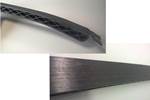Post Cure: Tool-less direct extrusion enables efficient, complex composite structure development
Backed by AI software, Hans Weber’s large-format 3D printing capabilities resulted in the successful development of a Savonius wind turbine blade in under two hours.
Source | Hans Weber Maschinenfabrik GmbH
Through more than 100 years of engineering experience and collective knowledge sharing with partners like aibuild and Reichenbacher Hamuel, (Kronach, Germany) seeks to enhance the adoption of large-format additive manufacturing (LFAM) for key applications.
One project involved the printing of a custom curved print bed, which was then used to print a Savonius wind turbine blade — a vertical-axis wind turbine that converts the force of the wind into torque via a rotating shaft — in under two hours (118 minutes) for one blade using Airtech Advanced Materials Group’s (Huntington, Calif., U.S.) Dahltram C-250CF resin with chopped carbon fiber.
The final part weighed only 2.1 kilograms. The use of AiSync — AI-powered 3D print software that reportedly makes customer tool paths 86% quicker, with 65% less failed builds, three times stronger parts and with more than 90% efficiency — provided precise control of the Weber extruder.
Aibuild’s in-house material testing also automatically set key printing parameters based on the material properties and behaviors.
Related Content
-
Orbital Composites wins AFWERX award for Starfighter drone fleet
Under the TACFI contract, Orbital is implementing the AMCM process to build 3D printed composite multi-mission UAS aircraft, surpassing $10 million in government awards.
-
Large-format AM speeds plug production for manufacture of composite boat molds
Hungarian manufacturer Rapid Prototyping transitioned its conventional foam milling process to 3D printing to produce faster, higher quality, recyclable foam plugs and composite boat molds.
-
Optimized rib-reinforced hollow composites via printed molds
Addyx topology optimization and water-soluble mandrel enables simultaneous rib and skin layup for one-shot, high-strength, lightweight structures.



